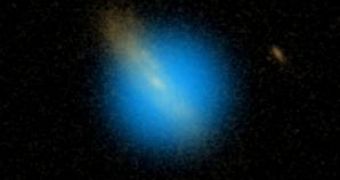Although it was theoretically predicted that some of the most massive stars in the universe emit a bright signal in the ultraviolet spectrum just before going 'nova', this is the first time when such a flash of light is observed. Most of the supernova events occurring in the visible universe are usually seen by astronomers after the progenitor star is destroyed, making it very difficult to actually tell the properties of the stars that triggered them.
"Astronomers have been dreaming about seeing the first light from the violent death of a star for over 30 years. Our observations open up an entirely new avenue for studying the final stages in the lives of massive stars and the physics of supernovae. It's very hard to tell much about precisely the kind of star that actually died there. The really cool thing about our observations is this light traveling ahead of the shock wave traveled through the star before it was destroyed. It's telling us about the properties, the conditions, of the star at the moment it died, but before the shock wave actually disrupted it", said Kevin Schawinksi from the University of Oxford, leader of the study.
As stars weighing more than 10 solar masses lose balance between the nuclear fusion reactions and the gravitational force acting on them, the core starts collapsing under its own weight while the outer layer of the star is ejected into the surrounding space at velocities of up to 10,000 kilometers per second, followed by an electromagnetic emission several billion times brighter than the Sun.
This is the bright flash of light astronomers usually see during or after the supernova explosion. By the time the supernova is discovered several weeks might have passed since the event took place. "If you see a supernova you'd have to go back in time. You'd have to be already looking at the position", said Schawinski.
Another problem related to the early detection of a possible supernova explosion is the well-known fact that Earth's atmosphere is most opaque in the ultraviolet spectrum, therefore any observations of the universe in the ultraviolet wavelengths need to be done from orbit. One of the spacecrafts currently present in Earth's orbit and capable of observing ultraviolet light is the Galaxy Evolution Explorer, located at an altitude that allows it to make a complete rotation around the planet in 98.6 minutes.
The observations made with GALEX reveal that the pre-nova star responsible for the ultraviolet flash is probably a red supergiant star measuring up to 1,000 times solar radii across. "We found a new source at the location of one supernova, suddenly outshining its galaxy host in the UV. It appeared a couple of weeks before the optical discovery of the supernova and marked the first stage in the death of the star", said Mark Sullivan from the University of Oxford.
As a red supergiant star goes nova, the Shockwave created by the collapsing core starts moving towards the outer layer. The related radiation however, travels faster than the shockwave reaching the surface first in order to raise the surface temperature up to several hundred thousand degrees Celsius. As the shockwave draws nearer to the surface, the surface luminosity suddenly peaks a thousand billion times that of the Sun.
The star is then destroyed as the shockwave reaches the surface and ejects the outer layer, which afterwards forms a supernova remnant that will remain bright in several wavelengths of the electromagnetic spectrum only to be later detected by astronomers.
But this time "we saw the whole thing. We saw the radiative precursor, this UV light, moving ahead of the shock wave. We saw that arrive and then the point at which the shock wave comes to the surface and destroys the star. In a sense we could see the shock move inside the star because the light from the shock was moving ahead of it", Schawinski said.

 14 DAY TRIAL //
14 DAY TRIAL //